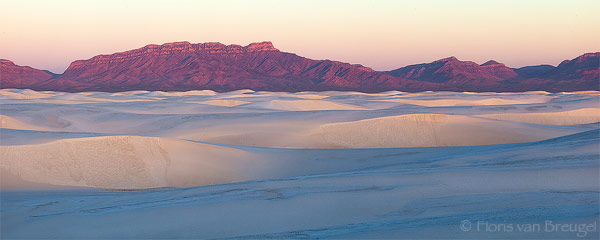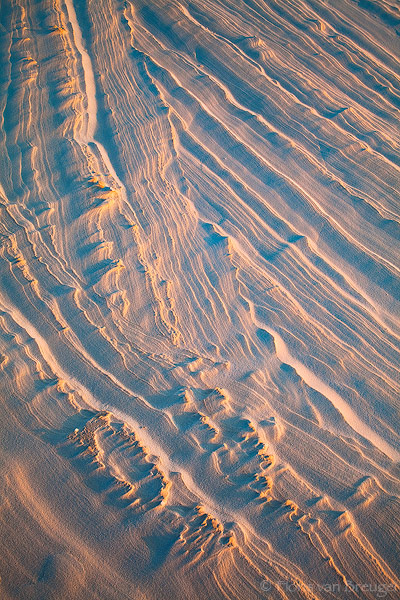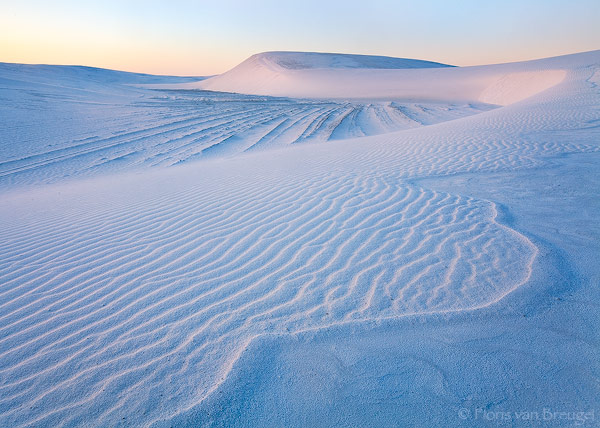
“Sand Waves” ~ White Sands National Monument
The Tech: Canon 5D2, 100-400mm, tripod
Exposure: iso 100, f/16, 1/10th sec
Notes: 4 exposure horizontal panorama stitched with PTGui
Click for larger view
In southern New Mexico lies one of America’s most surreal and moving landscapes: White Sands National Monument. In addition to (somewhat ironically) being part of America’s largest missile test range (tests happen about twice a week – we didn’t see any when we were there), White Sands is home to a 275 square mile expanse of psychadelic white dunes composed of tiny shimmering gypsum crystals. It’s such a brilliant white you could easily mistake it for fresh snow, except that it’s warm and silky to the touch. I had been here once before, a long time ago, and have wanted to go back ever since. I finally made the trip out there last weekend with a friend of mine and camped out in the dunes for two nights.. it is without a doubt one of the most incredible places I have ever been.

“Camp Surreal” ~ White Sands National Monument
The Tech: Canon 5D2, 24-105mm, tripod
Exposure: iso 400, f/16, 0.4 sec
Notes: The iso 400 was not entirely necessary, though it was rather windy at the time.

“Blowing Sands” ~ White Sands National Monument
The Tech: Canon 5D2, 24-105mm, tripod
Exposure: iso 200, f/16, 1/50th sec
We arrived in the afternoon after a storm system had dumped a significant amount of rain on the dunes, and as it cleared over the course of the evening and throughout the night the high winds swept the entire place clean of any tracks. The combination of rain and wind also created a variety of interesting patterns in the sand beyond the usual dune ripples. In fact, it was as if you could see the beginnings of the beautiful striated sandstone structures of the fossilized dunes found throughout Utah and Arizona such as at ‘the wave’. In the last few minutes of sunlight the white baby sandstone even took on a beautiful orange tint, taking it just one step closer to what I would expect to find only on the Colorado Plateau.

“Birth of Sandstone” ~ White Sands National Monument
The Tech: Canon 5D2, 24-105mm, tripod
Exposure: iso 400, f/16, 1/4th sec
Notes: The iso 400 was not entirely necessary, though it was rather windy at the time. Fortunately noise and sand are almost indistinguishable in an image like this, not that the 5D2 has much noise at 400.
While the windy conditions made for some great photographic opportunities it also made for a long and restless night – but the insomnia was worth it! The brilliant white sand was left in a spectacularly pristine state, disturbed only by beetle and lizard tracks.

“Tracks” ~ White Sands National Monument
The Tech: Canon 5D2, 24-105mm, tripod
Exposure: iso 100, f/18, 1/4th sec
The most common critters out there were by far the darkling beetles, which aimlessly wandered the sand in search of who knows what. You’d think a black beetle like that would be easy prey out in the sparkling white dunes, but I suppose their defense mechanism of raising their rear and emitting noxious gasses, as it was doing in this photo (I couldn’t smell anything, though), is enough to keep them out of most harms way.

“Darkling Defense” ~ White Sands National Monument
The Tech: Canon 5D2, 24-105mm, handheld
Exposure: iso 800, f/16, 1/160th sec
The sand is so reflective that even at night under a half full moon we didn’t need any lights at all to see. Of course, during the heat of the day that brilliance could probably give you “snow blindness” if you’re not careful! All dunes seem to do a wonderful job at reflecting colors at sunrise and sunset, but these white sands reflected even the subtlest of palettes – in particular a lot of cool tones from the clear blue skies overhead.

“Sea of Gypsum” ~ White Sands National Monument
The Tech: Canon 5D2, 16-35mm mkII, tripod
Exposure: iso 100, f/18, 1/4th sec
Notes: Using various selection methods I brought out the warmth and pinks of the sand a little extra to enhance the visual color contrasts.
Most of the photographs you will likely see of White Sands seem to focus on the lonely Yuccas that struggle to call this place home. While ordinarily I love such lonely subjects and compositions, I focused all of my attention of this short trip on capturing the elegance and purity of the unmarred whiteness. There’s a certain spiritual quality to it that while I know I did not capture completely, I hope that I’ve at least managed to share a glimpse of this special place and perhaps inspired you to make the trip out there yourself one day.
Thanks for visiting my blog! If you are interested in purchasing prints simply click the image you like and it will take you to that image on my official website where you will find a variety of print purchase options.
Tags: desert, dunes, New Mexico, white sands national monument


The texture and lines in that last one are incredible. Not that any of them are “bad’ 😉 I’ve been dying to get down there for some time now and your post is just that extra kick in the butt I needed 🙂
I’ve been a reader of your blog for quite some time. I live in the Alamogordo area and frequent the monument. Your beetle image is awesome awesome awesome. For me it’s a new idea for an area I’ve shot more ways than I know. Thanks for the inspiration.
Tom
Aleks – I figured that one would be the most popular 🙂
Thanks Tom, glad you enjoyed that one!!
Your post did just what you hoped – it has inspired me to visit those dunes someday. I am hoping for a trip through the southwest within a year or two and this place will be on my “must visit” list. Thanks for the wonderful photos. I especially liked #3, 4, & 5 – guess I’m in an abstract mood.
Wow, top notch photography here. I particularly like “Birth of Sandstone,” “Darkling Defense” and “Sea of Gypsum.” White Sands is a powerful place to photograph. My father, landscape photographer Philip Hyde had a project at White Sands many years ago that enabled him to get into the Missile Range where nobody else had photographed. From then on he made a point of going to White Sands if he ever was within 300 miles of it. Dunes anywhere are addictive for a photographer, but something about that white sand that is even more compelling.
Wow, spectacular imagery as usual! This place is very high on my list of places to see in the US.